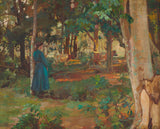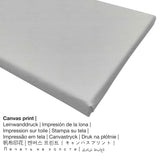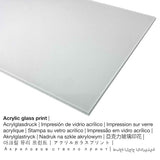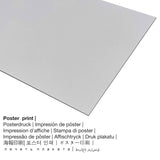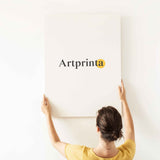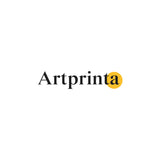Nhọrọ ihe dị
We offer a range of various materials and sizes for every product. Choose your favorite material and size among the preferences:
- Akwụkwọ mmado ebipụtara (akwa akwa akwa): Our poster print is a printed sheet of canvas paper with a granular structure on the surface. Please bear in mind, that depending on the absolute size of the canvas poster print we add a white margin 2-6cm around the print motif, which facilitates the framing with your custom frame.
- Mbipụta iko acrylic na-egbuke egbuke: A glossy acrylic glass print, which is sometimes described as a UV print on plexiglass, will convert the artwork into décor. The work of art is manufactured with modern UV direct print technology. It makes rich and sharp colors. With an acrylic glass fine art print sharp contrasts and small color details will be more recognizeable thanks to the fine gradation in the print. The acrylic glass protects your chosen fine art print against light and external influences for between 4 and 6 decades.
- Metal (aluminium debond mbipụta): An Aluminium Dibond print is a print material with an impressive effect of depth - for a modern look and non-reflective surface structure. For our Direct Aluminium Dibond print, we print your selected artpiece onto the aluminium surface. The white and bright parts of the artpiece shimmer with a silk gloss, however without glare.
- Mbipụta kwaaji: A printed canvas, not to be mistaken with a real canvas painting, is an image printed on a cotton canvas. Your canvas print of this artpiece will let you turn your fine art print into a large size artwork. How can I hang a canvas print on the wall? The great advantage of canvas prints is that they are relatively low in weight, which implies that it is easy to hang the Canvas print without the use of any wall-mounts. Therefore, canvas prints are suited for all kinds of walls.
Ederede iwu dị mkpa: We try to describe the products as clearly as it is possible and to exhibit them visually. Nonetheless, the pigments of the printing material, as well as the printing may diverge somehwat from the presentation on your monitor. Depending on the settings of your screen and the condition of the surface, color pigments can unfortunately not be printed as exactly as the digital version. Because all are processed and printed manually, there may also be slight variations in the motif's size and exact position.
Ihe ngosi nka sitere na ụlọ ngosi nka (© Nwebiisinka - site na Museum of New Zealand - Te Papa Tongarewa - Museum of New Zealand - Te Papa Tongarewa)
Fetching the cows, 1911, New South Wales, by James Scott. Purchased 2005. Te Papa (2005-0026-3)
Ozi ndabere na oyiri nka nke eserese Fetching the cows
The 20th narị afọ sere Fetching the cows mere site na oge a nwe- James Scott. Nke mbụ nwere nha: Image: 20mm (width), 613mm (height), 754mm (length) ma were ihe osise ese Usoro mmanụ na kwaaji. Ihe osise a dị n'ime Museum of New Zealand - Te Papa Tongarewa's nchịkọta nka dijitalụ, nke dị na Te Aro, Wellington, New Zealand. a nkà nke oge a ngalaba ọha A na-enye mpempe nka site n'ikike nke Fetching the cows, 1911, by James Scott. Purchased 2005. Te Papa (2005-0026-3). Furthermore, the artwork has the following creditline: Purchased 2005. Moreover, alignment of the digital reproduction is in odida obodo format with a side ratio of 1.2 : 1, which means that the length is 20% longer than the width. James Scott was a male engraver, whose style can mainly be assigned to Modern Art. The European artist lived for 100 years and was born in 1799 na London, Greater London, England, United Kingdom wee nwụọ na 1899.
Nkọwa nka ahaziri
| Aha nka: | "Fetching the cows" |
| Nhazi nka nka: | sere |
| Okwu mkpokọta: | nkà nke oge a |
| oge: | 20th narị afọ |
| Emepụtara n'afọ: | 1911 |
| Afọ nka: | 100 afọ |
| Usoro nka izizi: | mmanụ na kwaaji |
| Nha izizi: | Image: 20mm (width), 613mm (height), 754mm (length) |
| Ụlọ ihe ngosi nka / ebe: | Museum of New Zealand - Te Papa Tongarewa |
| Ebe ngosi nka: | Te Aro, Wellington, New Zealand |
| Ebe nrụọrụ weebụ ihe ngosi nka: | Museum of New Zealand - Te Papa Tongarewa |
| Akwụkwọ ikike nka: | ngalaba ọha |
| Site n'aka: | Fetching the cows, 1911, by James Scott. Purchased 2005. Te Papa (2005-0026-3) |
| kreditline ọrụ nka: | Azụtara 2005 |
Ngwaahịa a
| Ụdị ngwaahịa: | nka nka |
| Usoro mmeghari: | dijitalụ mmeputakwa |
| Usoro mmepụta: | Mbipụta UV / dijitalụ |
| Production: | arụpụtara na Germany |
| Ụdị ngwaahịa: | a na-achọ |
| A na-atụ aro iji ngwaahịa eme ihe: | nka mgbidi, mma mgbidi |
| Ndepụta: | usoro odida obodo |
| Oke akụkụ: | 1.2: 1 - ogologo: obosara |
| Oke akụkụ pụtara: | ogologo bụ 20% ogologo karịa obosara |
| Ụdị ihe dị iche iche dị: | mbipụta akwụkwọ mmado (akwụkwọ kwaaji), mbipụta kanvas, mbipụta enyo acrylic (nwere ezigbo mkpuchi iko), mbipụta ọla (aluminium dibbond) |
| Nhọrọ nke Canvas Mbipụta (akwa akwa na etiti ihe ndọtị): | 60x50cm - 24x20", 120x100cm - 47x39", 180x150cm - 71x59" |
| Mbipụta iko acrylic (nke nwere ezigbo mkpuchi iko): | 60x50cm - 24x20", 120x100cm - 47x39" |
| Nhọrọ nha nke akwụkwọ mmado (akwụkwọ kwaaji): | 60x50cm - 24x20", 120x100cm - 47x39" |
| Nhọrọ nha nha nke aluminom dibond (ihe aluminom): | 60x50cm - 24x20", 120x100cm - 47x39" |
| Nhazi mbipụta nka: | agunyeghi |
Tebụl metadata omenkà
| aha: | James Scott |
| A makwaara dịka: | James Scott, Scott James |
| okike nke onye nka: | nwoke |
| Obodo onye nka: | British |
| Ọrụ onye na-ese ihe: | ihe osise |
| Mba onye si: | United Kingdom |
| Nhazi nke onye nka: | omenkà nke oge a |
| Ụdị nke onye na-ese ihe: | Art |
| Akwụsị: | 100 afọ |
| Afọ amụrụ: | 1799 |
| Ebe omuma: | London, Greater London, England, United Kingdom |
| Nwuru: | 1899 |
© Nwebiisinka nke, Artprinta (www.artprinta.com)

